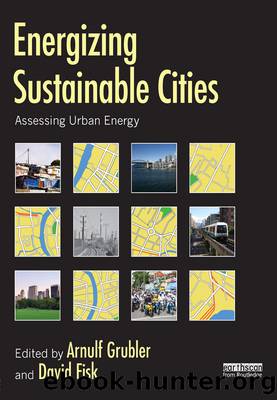Energizing Sustainable Cities by Grubler Arnulf;Fisk David;

Author:Grubler, Arnulf;Fisk, David;
Language: eng
Format: epub
ISBN: 1075441
Publisher: Taylor & Francis Group
Cities depend on extended energy networks and failures can occur on a regional and national scale. On August 14, 2003, a cascading outage of transmission and generation facilities in the North American Eastern Interconnection resulted in a blackout of most of New York State as well as parts of Pennsylvania, Ohio, Michigan, and Ontario, Canada. On September 23, 2003, nearly four million customers lost power in eastern Denmark and southern Sweden following a cascading outage that struck Scandinavia. Days later, a cascading outage between Italy and the rest of central Europe left most of Italy in darkness on September 28. These major blackouts are among the worst power-system failures in the past few decades. They had a profound effect on power-system philosophy because these networks were some of the world's most sophisticated power-generation distribution systems. In particular, the US failure was promoted by an early underlying failure in software used to control networks, which meant the scale of the emerging problem was recognized too late to prevent the cascading failure.
Energy efficiency and energy resilience are not entirely coincidental outcomes. Thus, a low-energy settlement might be even more sensitive to disruptions in supply than a settlement with some slack in its energy system because the low energy settlement is always operating at its minimum. A dense high efficiency city with no power for its elevators may be in a worse state than a low-density urban settlement without power. Renewable power sources based on wind or solar alter the reliability profile. As they are of a much smaller unit size, they do not induce major dropouts, as happens when a large nuclear power station needs to come offline very rapidly. While often termed âintermittentâ this term is better reserved for conventional plant failure. A better term would be âvariableâ. Conversely, the variability in available power they supply may require them to be shadowed by a rapid-response plant. They may also exacerbate failure cascades because of switching out for self-protection when the power system is stressed heavily. Urban energy looks destined to be less reliable than it once was in the developed world of the 1960s.
The increasing dependency on power even for simple clerical tasks, let alone for critical functions such as hospitals, means that stand-by power supplies could be an increasing feature in urban systems. One radical suggestion (Patterson 2009) is that it is possible for the local distributed power generation to become dominant and the national distribution systems only handle back-up. This is already effectively the case for dwellings that use micro-generators for power and heat. Another suggestion is that more sophisticated metering and tariffs could incentivize the extension of demand-side load management from large facilities of âinterruptible supplyâ at the micro scale. In line with the efficiencyâresilience argument it is expected that vulnerability to societal interruption is higher in countries with generally very secure supplies in which the economy has sought an equilibrium that assumes secure power supplies than in countries with frequent brownouts and blackouts in which the economy has adjusted to coping with the risk.
Download
This site does not store any files on its server. We only index and link to content provided by other sites. Please contact the content providers to delete copyright contents if any and email us, we'll remove relevant links or contents immediately.
Audition by Ryu Murakami(4610)
The Body: A Guide for Occupants by Bill Bryson(4579)
Adulting by Kelly Williams Brown(4230)
Housekeeping by Marilynne Robinson(4059)
Zero Waste Home by Bea Johnson(3652)
Be in a Treehouse by Pete Nelson(3643)
Seriously... I'm Kidding by Ellen DeGeneres(3412)
Better Homes and Gardens New Cookbook by Better Homes & Gardens(3368)
The Healing Self by Deepak Chopra(3252)
Barkskins by Annie Proulx(3191)
The Life-Changing Magic Of Tidying Up- The Japanese Art Of Decluttering And Organizing (v5.0) by Marie Kondo(3097)
Hedgerow by John Wright(3095)
Spark Joy by Marie Kondo(3083)
The Cellar by Natasha Preston(3073)
The Genius of Japanese Carpentry by Azby Brown(3033)
120 Days of Sodom by Marquis de Sade(2935)
Work Clean by Dan Charnas(2888)
A Monk's Guide to a Clean House and Mind by Shoukei Matsumoto(2782)
The Book of Numbers by Peter Bentley(2779)
